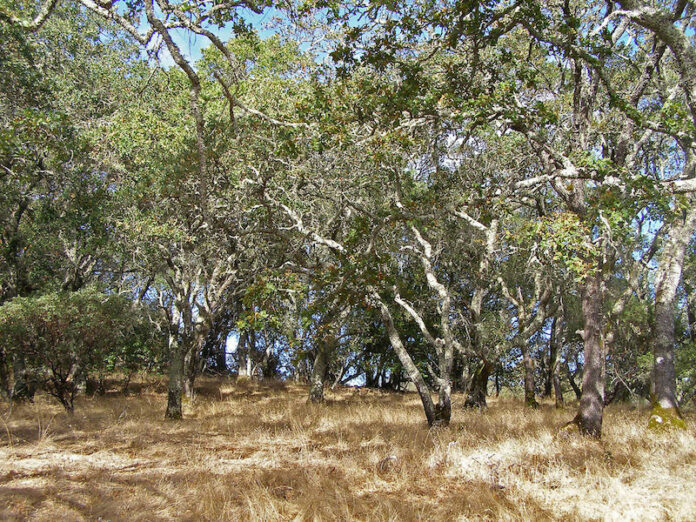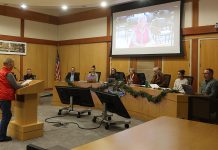
A group of conservationists from Sonoma County Conservation Action is urging the Sonoma County Board of Supervisors to consider implementing a moratorium on county permitted tree cutting in an effort to save and preserve Sonoma County’s iconic oak woodlands.
“For decades, Sonoma County’s iconic oak forests have been excessively cleared in the name of development and vineyards. Much of this county-permitted cutting is being done without rigorous regard for the ecological importance of native oak and forest lands,” said Aja Henry, an assistant field manager with Sonoma County Conservation Action. “A moratorium on tree cutting is imperative for our native habitats as well as our ecological footprint as a county. If we are to really become carbon neutral by 2050, we need a moratorium on cutting until we have a clearer picture of the situation and have developed a realistic climate-oriented tree ordinance to regulate cutting in the future.”
On Sept. 17, 2019, the Sonoma County Board of Supervisors declared a Climate Change Emergency and pledged to support a countywide framework for reducing greenhouse gas emissions, and to pursue local actions that support to protect and enhance the value of working lands and increasing carbon sequestration.
Henry feels that protecting native woodlands would be one way the county could increase carbon sequestration since mature forests store significantly more carbon than younger or newly planted trees.
“Oak forests sequester carbon in the form of biomass, deadwood, litter and in forest soils. The sink of carbon sequestered in forests helps to offset other sources of carbon dioxide in the atmosphere, such as deforestation, forest fires and fossil fuel emissions. We have a powerful tool to fight climate change right in our backyard, and we are chopping it down without a careful study of the repercussions,” Henry wrote in a recent Sonoma County Conservation Action newsletter.
Kimberly Burr, a local environmental lawyer who’s been working with Sonoma County Conservation Action, said a lot of the county permitted tree clearing is occurring on large properties and ahead of development projects.
“There’s a large one now east of Cloverdale and it even happened in the Laguna de Santa Rosa at the end of 2019,” Burr said.
Currently, the group is working on getting the work out and creating a coalition of support for the moratorium according to Henry.
As Henry said, a tree clearing moratorium — which would be in effect for about three months — would be just the first step in the group’s efforts to reduce oak tree cutting in the county.
“This whole thing started when we realized that county policy allowed pretty big clearings of trees, so we’ve been trying to work hard to really improve our understanding of that and see if we can get that changed … While the policy is being developed, there’s nothing stopping acres and acres of lost woodlands. It (the moratorium) is common sense and it’s been done before and it’s not unusual that a timeout would be put in place so that the policy can be worked out,” Burr said.
The group, along with Burr, hope to one day put a new county ordinance or policy in action that would further protect local oaks.
“There is a tree ordinance right now called the Tree Protection Ordinance and it (their new ordinance) would probably be something that would modify or replace that. That one (the current one) is kind of ineffectual so we are looking at a comprehensive tree protection policy and that would definitely be in the form of an ordinance,” Burr said.
Matthew Callaway, the canvassing director for Sonoma County Conservation Action, said the moratorium would be a way to give the county time to create a reasonable ordinance.
“We want to give the county enough time to make a reasonable tree ordinance that’s really based on science and we want this to be something that can last for a long time,” Callaway said.
When asked if any of the supervisors have given any indication that they’d support a new ordinance and a moratorium, Burr said they’ve had some good conversations with the board of supervisors.
“We haven’t chatted with all of them yet, but we’re hopeful and we think that science speaks for itself and we’re really hopeful that the supervisors will listen to that and put science into policy,” Burr said.
Henry, Burr, Callaway and Larry Hanson of Forest Unlimited (a nonprofit organization aimed at protecting, restoring and enhancing Sonoma County forests and watersheds) have been working on this initiative for several years now and Callaway said with the continuation of climate change hopefully people will see the importance and relevance of a protective tree ordinance.
“The board of supervisors put in a climate emergency declaration last year … and they made it very clear that things like carbon sequestration and climate change abatement are priorities and so we’re giving them basically a free way to sequester hundreds of thousands of pounds of carbon. A lot of things like this reach a tipping point where we can start driving it home,” Callaway said.
The trees aren’t just important for their carbon sequestration powers. According to Henry, the oak is a keystone species that supports 100 other species in its surrounding ecosystem.
“Oaks are the backbone of many different forest communities and provide immeasurable ecosystem services,” Henry wrote in the same newsletter.
Hanson, who’s been working on tree conservation for nearly 25 years, said the value of trees and oak forests to local ecosystems has always been important, but now with climate change their value is even more important.








